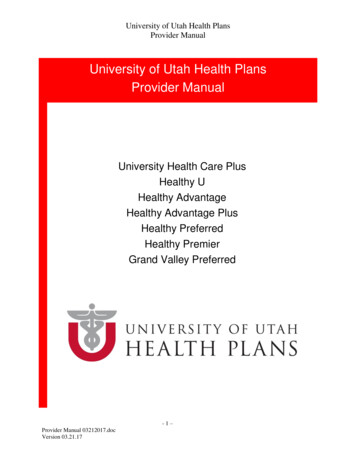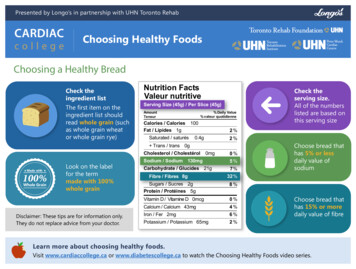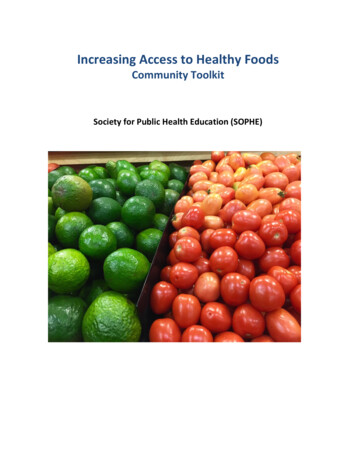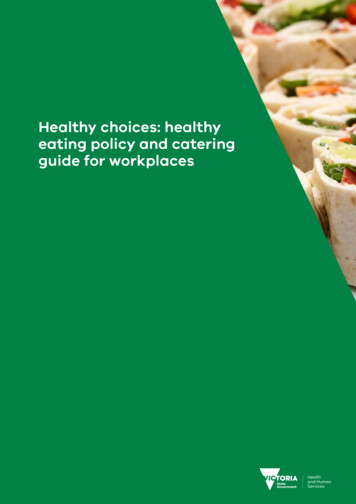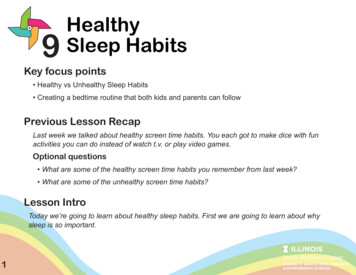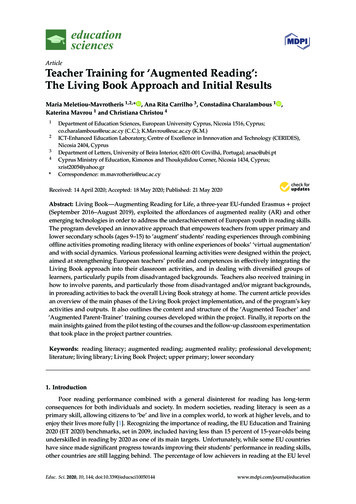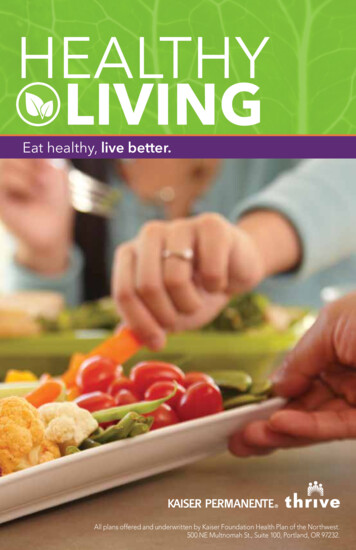
Transcription
HEALTHYLIVINGEat healthy, live better.All plans offered and underwritten by Kaiser Foundation Health Plan of the Northwest.500 NE Multnomah St., Suite 100, Portland, OR 97232.
EAT HEALTHY. LIVE BETTER.“I have learned that 70 to 80 percentof the problems I see as a primary caredoctor can be prevented, improved,or cured with a healthy diet.”— Craig McDougall, MD, Internal Medicine, Kaiser PermanenteEveryone knows that eating healthy can help you feel better andmaintain a healthy weight. But did you know that good nutrition canalso improve chronic conditions such as heart disease, high cholesterol,diabetes, and high blood pressure?Changing your diet can be a tall order for anyone. That’s why we’reoffering you this personalized physician-led Healthy Living programwith Craig McDougall, MD, a board-certified internal medicine doctor,and the Healthy Living team.
PERSONALIZED ADVICEDr. McDougall is passionate about nutrition and how it can improve yourhealth. Through this program, you can change your nutrition and lifestyleto help treat and potentially reverse chronic medical conditions such asdiabetes, heart disease, hypertension, and obesity.Healthy Living consultationsTogether with Dr. McDougall and the Healthy Living team, you will: Define your health goals. Discuss your current medications. Talk about how a whole-foods, plant-based diet can help youlive healthy. Implement your goals into your daily life. Share your progress, including your successes and obstaclesto overcome.Next steps — on the right path Enroll in Kaiser Permanente Healthy Living Program through yourPrimary Care Doctor or by calling 503-278-9259. Attend personal consultations with Dr. McDougall and the HealthyLiving team. Weekly or biweekly consultations are available by phone or email. Group education classes and cooking demonstrations. Community support through social media. Ongoing support with the Healthy Living Program team.3
THE PLANT-BASED DIET:a healthier way to eatPresented by Kaiser Permanente“Eat food. Not too much.Mostly plants.”— Michael Pollan1Start with a simple assessment:1. Are you open to changing your diet if it could really improveyour health?2. Do you want to lose weight?3. Do you want to feel better?4. Do you want to improve, stabilize, or even reverse a chroniccondition such as heart disease, high cholesterol, diabetes,or high blood pressure?If you answered “yes” to any of these questions, then a plant-basedeating plan may be for you. This booklet includes information to helpyou follow a low-fat, whole-foods, plant-based diet.1In Defense of Food: An Eater’s Manifesto (New York: Penguin, 2009)5
WHAT IS A LOW-FAT, WHOLE-FOODS,PLANT-BASED DIET?This eating plan includes lots of plant foods in their whole, unprocessedform, such as vegetables, fruits, beans, lentils, seeds, whole grains, andsmall amounts of unprocessed plant fats. It does not include animalproducts, such as meat, poultry, fish, dairy, and eggs. It also does notinclude processed foods, including oil and sweets.“Eat more, weigh less.”— Hans Diehl, DrHSc, MPH
WHAT ARE THE HEALTH BENEFITSOF A PLANT-BASED DIET? Lower cholesterol, blood pressure, and blood sugar. Reversal or prevention of heart disease and diabetes. Longer life. Healthier weight. Lower risk of developing cancer and diabetes. May slow the progression of certain types of cancer. Improved symptoms of rheumatoid arthritis. Fewer medications. Lower food costs.It’s also good for the environment.Best of all, a plant-based diet can be a tasty, affordable, and enjoyableway to eat!Need convincing? Try a 30-day challenge. Use the information in thisbooklet to eat a plant-based diet for the next 30 days and see if it has apositive impact on your health. If it does, continuing with a plant-baseddiet may be a great option for you.Disclaimer: The information and advice published is not intended for use in or as a substitutefor the diagnosis or treatment of any health or physical condition or as a substitute for aphysician-patient relationship which has been established by an in-person evaluation of apatient. Do not change your diet if you are ill or on medication, without the advice of a qualifiedhealth care professional such as your physician.7
YOUR NEW FOOD GROUPS“If it came from a plant, eat it;if it was made in a plant, don’t.”— Michael Pollan2Use the chart on the following pages to help you choose the foods thatyou will need to thrive on your new eating plan.Tips If you want to lose weight, choose a lower number of servings ofnuts, seeds, and tofu. Choose unprocessed, whole foods instead of processed foods mostof the time. Choose whole grains (barley, quinoa, or brown rice) more often thanprocessed grains (bread or pasta). Avoid processed vegan or vegetarian “meats” and “cheeses.” Avoid all kinds of processed oils. If you have diabetes or high triglycerides, limit fruit to 2 servings a day. Do not focus on portion control. Focus on calorie density instead.2Food Rules: An Eater’s Manual (New York: Penguin, 2009)9
FOOD GROUPEXAMPLES OF FOOD CHOICESTubers andstarchy vegetablesPotatoes, yams, winter squash, corn, greenpeas, cassava (yucca) plantainsBeans, peas,and lentilsKidney, black, garbanzo, pinto, greatnorthern, and adzuki beans; lentils; edamame(green soybeans); green and black-eyed peas;tofu; tempehWhole grainsWhole grains: bulgur, quinoa, oats, brown orwild rice, buckwheat, barley, faro, whole wheat,rye, millet, sorghumProcessed grains: whole-grain bread, wholegrain unsweetened cereal, whole-wheat tortillas,whole-wheat pastaNon-starchyvegetablesSpinach, kale, Swiss chard, mustard greens,collard greens, broccoli, bok choy, carrots,cauliflower, asparagus, green beans, brusselsprouts, celery, eggplant, mushrooms, onions,garlic, tomatoes, lettuce, sugar snap peas,summer squash, peppers, artichoke hearts,cabbage, cucumbersFruitsApples, oranges, bananas, berries, melon,papaya, grapes, mango, pineapple, kiwi, apricotsHigh fat plant foodsAlmonds, cashews, sunflower seeds, walnuts,pistachios, flaxseeds, chia seeds, nut butter,avocado, tofuSuggested dairysubstitutesUnsweetened milks, such as soy, almond,rice, and hemp (look for brands fortified withvitamin B12)10
DAILY SERVING SIZESERVING SIZE; PROTEIN2–4 servings½ cup: 2 grams2–5 servings½ cup cooked beans: 7–10 grams5–8 servings½ cup cooked grain, ¾ cup drycereal, 1 slice bread, 1 small tortilla:4–8 gramsUnlimited, but eat at least 6 servingsa day. Include at least 1 serving ofleafy green vegetables a day.1 cup raw lettuce or other leafygreens; ½ cup raw or cooked, anyother vegetable: 2 grams2–4 servings1 medium piece, 1 cup berries ormelon: ½–1 gram0–4 servings1 ounce (¼ cup) nuts, 2 tablespoonsnut butter: 4–8 grams0–2 servings1 cup milk: 1–9 grams11
TIPS TO GET STARTEDThink about the meatless meals you already cook athome. This may include whole-wheat pasta with marinarasauce, black beans and rice, or lentil soup and salad.Change a favorite recipe to be plant-based. Make burritos or tacos with beans, rice, and vegetablesand without the meat and cheese. Prepare chili with beans and no meat. Replace burgers with whole grain veggie burgers orgrilled portobello mushrooms. Make kebabs with vegetables, such as onions,bell peppers, summer squash, and mushrooms. Make lentil or split pea soup without meat.Try some new recipes. At the end of this booklet you willfind a list of suggested books and websites that have recipesyou can try.Frozen fruits and vegetables are an easy and low-costway to eat more plants.Canned vegetables are another easy and low-cost wayto eat more plants.13
When you cook beans from scratch, the quick-soakmethod can help remove some of the indigestible sugarsthat cause gas. Put the beans in a large pot and cover with 2 inchesof water. Bring to a boil for 3 minutes. Cover and set aside for 1 to 4 hours. Rinse and drain well.Cooking vegetables without oil: When you are sautéingvegetables on the stovetop, simply replace the oil younormally use with water or vegetable broth. Vegetablesnaturally have a lot of water in them, which releases whenthey are cooked, so this is why we only need to add a smallamount of water or broth. Just keep an eye on your pan sothat your vegetables don’t stick.The nice thing about sautéing in water or broth is that youend up tasting more of the food instead of the oil. If youare roasting or baking vegetables, you also do not need touse oil. These foods will still cook, and if left in long enough,they will lightly brown.Baked goods: Instead of oil, use other moist foods, such asbananas, apples/applesauce, soaked dried fruit (like raisinsor prunes), dates and tofu. In preparing your pans for bakingcakes, breads, or cookies, you can use parchment paperinstead of oil or silicone bakeware.Check out a local farmers market for good dealson produce.15
Salad Dressing: For salad dressings, simply omit the oilaltogether and leave it at that, or then add a little water orjuice to make up for the lost volume.Sometimes, cooking plant-based meals can take moretime. To save time: Make a larger pot of beans or lentils and freeze somefor later. Buy precut fresh or frozen vegetables. Buy precooked grains, such as barley, faro, or brownand wild rice. When baking yams or potatoes, make a few extra touse in the next meal. Use canned beans, including nonfat refried beans.If your family is not following a plant-based diet with you: Cook meat separately and add it to the other plant-based foods. Encourage your family to try more meatless meals. Try new recipes they might enjoy, such as five-beanchili without meat or portobello mushroom burgers.You might need to add a few items to yourkitchen, including: A good chef’s knife to cut vegetables, fruits, and otherplant-based foods. A blender or food processor. A large pot, pressure cooker, or crockpot to cook beans. A good non-stick pan.Make sure to drink plenty of water. It is best to avoidjuice, soda, and other sugary drinks.17
HOW TO READ A FOOD LABEL3FAT: Less than 20 percentof the number of caloriesper serving.TIP: Divide number of caloriesfrom fat by number of caloriesper serving.TRANS FAT: No trans fat.TIP: Avoid margarine,shortening and partiallyhydrogenated oils in theingredients list.CHOLESTEROL: ZeroSODIUM: less than thenumber of calories per serving(i.e., 1:1 ratio or less).FIBER: 2-3 grams per serving.3Adapted from UC Davis Health System, 2014.
THE PLATE METHODCalorie density to meet your goalsFollow the 50/50 guideline:4 Start with soup and/or salad. 50% non-starchy vegetables (cruciferous, leafy greens) and/or fruits(sweet, citrus, melon, berries). 50% tubers (potato, yam, sweet potato), starchy vegetables (wintersquash), intact whole grains (brown rice, quinoa), and/or legumes(peas, lentils, beans). Drink water. Finish with fruit.4Adapted from Jeff Novick, 2014.19
MEAL IDEASBreakfast: Have oatmeal, quinoa, or barley with nuts, fruit, andunsweetened almond, rice, hemp, or soy milk. Add a piece of fruit ontop for another quick and easy option.Lunch and dinner: Have salad to start and then have a large serving ofcooked non-starchy vegetables with beans and potatoes or a whole grain.SAMPLE MENU: DAY ONEBreakfast Barley with raisins, cinnamon, walnuts, and almond milk. Hot tea, coffee, or water.Lunch Whole-wheat pita with hummus, tomatoes, red onions, and cucumber. Kale sautéed with vegetable broth. Salad with vegetables and balsamic vinegar. Banana. Unsweetened tea or water.Dinner Grilled portobello mushroom burger with caramelized onions. Quinoa and bean salad. Broccoli. Kale salad. Strawberries. Unsweetened tea or water.21
SAMPLE MENU: DAY TWOBreakfast Oatmeal with blueberries, walnuts, and soy milk. Hot tea or coffee.Lunch Split pea, carrot, and barley soup. Salad with spring mix, vegetables, kidney beans, and balsamic vinegar. Orange. Sparkling mineral water or water.Dinner Tacos with corn tortillas, grilled vegetables, potatoes, avocado, and salsa. Pinto beans. Salad with vegetables and balsamic vinegar and mustard. Mango. Sparkling mineral water or water.TIPS FOR EATING OUTMany restaurants offer some meatless options or side dishes. Restaurantsare often willing to make changes to menu items by switching tomeatless sauces, removing meat from stir-fry, adding vegetables or pastain place of meat, and using less or no oil. Remember to use cautionwhen eating out because many dishes have added oil. Do not be afraidto ask for no or less oil.Restaurants that make food to order may be more willing to make thesechanges. Many cuisines, such as Mexican, Japanese, Indian, Chinese,and Thai, offer a variety of plant-based dishes and sides. Check thewebsite happycow.net to find a meatless restaurant near you.22
NUTRIENTS TO CONSIDEROverall deficiency of any of the following on a whole-foods, plant-baseddiet is exceedingly rare. If deficiencies occur, it is more likely to be fromanother cause or inadequate caloric intake rather than from your newdiet. The only exception to this is vitamin B12.Vitamin B12Your body needs vitamin B12 to make red blood cells and for nervefunction. If you don’t get enough B12, you can develop anemia ornerve damage. Vitamin B12 is made by bacteria and is found in higherconcentration in animal foods. But B12 requirements can be met innutritional yeast and some fortified foods such as: Cereals. Rice or hemp milk.It is helpful to read labels for these products to make sure B12 hasbeen added.Because it may not be easy to get enough B12 from fortified foods,it may be best to take a supplement. Talk with Dr. McDougall or theHealthy Living team for more information. A B12 level is routinelychecked with your enrollment in the Healthy Living Program.23
CalciumCalcium helps build bones and teeth. It is also important for the functionof the heart, muscles, and nerves. Good sources of calcium are Chinesecabbage, bok choy, kale, calcium-set tofu, and broccoli. There are alsomany calcium-fortified foods, such as soy or almond milk and cereal.ProteinProtein is in every cell of the body. It is used to build and repair muscles,bone, skin, and the immune system. We also need it to make hormonesand enzymes. Proteins are made up of amino acids. Your body can makesome of the amino acids, but not all of them. The ones your body cannotmake are called essential amino acids. You can easily meet your proteinneeds each day from plant foods.IronIron is a mineral in the blood that carries oxygen. Getting enoughiron is important for everyone, especially pregnant women, women ofchildbearing age, children, and infants. Iron-rich plant foods includewhole-grain breads and cereals, dried beans and peas, dark green leafyvegetables, dried fruits, nuts, and seeds. Some foods, such as breakfastcereals, are fortified with iron. The type of iron found in plant foods is notabsorbed as easily as the iron in animal products. However, eating ironrich foods along with vitamin C can help your body better use the iron.Some foods with vitamin C are oranges, mangos, kiwis, strawberries, redpeppers, tomatoes, broccoli, and bok choy.ZincZinc is important for the immune system, wound healing, and bloodsugar control. Good sources are whole grains, sprouted grains, tofu,tempeh, beans, peas, lentils, nuts, seeds, and fortified breakfast cereals.24
Vitamin DVitamin D is actually a hormone. It is needed for strong bones. It is alsoneeded for muscles and nerves and for the immune system to workproperly. We get most of our vitamin D when our skin is exposed to thesun. Very few foods naturally have vitamin D. Some foods, such as soyor almond milk and cereal, have added vitamin D. It is important to getoutside and get a limited amount of unprotected sun exposure. If youare not able to get outside enough, you may need a supplement. Talk toDr. McDougall or the Healthy Living team if you have any questions orconcerns about this.Omega-3 fatty acidsOmega-3s are used in the formation of cell walls and assist inimproving circulation. Omega-3 fatty acids include alpha-Linolenic acid(ALA), eicosapentaenoic acid (EPA), and docosahexaenoic acid (DHA).Good sources of plant-based omega-3 fats include flaxseeds, blackbeans, winter squash, walnuts, and chia seeds. It is important toremember that all plant proteins contain varying amounts of omega-3in the form of ALA. Your body then converts ALA to EPA and DHAas required.Tell your doctor you are on a plant-based diet A plant-based diet can affect your thyroid or blood-thinningmedications, such as warfarin (Coumadin). If you are taking medications, Dr. McDougall and the Healthy Livingteam may need to change some or all of your medications. We willmake sure to notify the other members of your health care team ofthese changes. Your health condition may need to be monitored more often for ashort time.25
MY PERSONAL ACTION PLANAction plans are short-term plans that help you reach your goals. Theycan greatly improve your chances of success. The plan must include aspecific action or behavior that you want to do and know you will beable to accomplish. Your action plan must answer the questions: What are you going to do? How much are you going to do? When are you going to do it? How many days of the week are you going to do it?EXAMPLE: This week I will eat a salad(what) made with 3 cups (how much)of tomatoes, carrots, artichoke hearts,kidney beans, and cucumber with dinner(when) on Monday, Wednesday,and Friday (how many days).
This week I will:(what)(how much)(when)(how many days)How confident are you that you will succeed with your plan?0123456789100 not confident at all10 totally confidentYour confidence level should be 7 or higher.I will make a commitment to(friend or family member) to follow my action plan and report back onhow I did.Did you complete your action plan?YesNoName:Date:Congratulations on taking this important step to increase yourhealth and wellness!Any movement toward more plants and few animal proteins can improveyour health. It is not an all or nothing diet. Discuss your barriers andconcerns with the Healthy Living team to see if new ideas and strategiescan be used.27
RESOURCESAt Kaiser Permanente, our goal is to keep you healthy through treatmentand prevention, based on solid evidence of what works for our members.Along with this guide, you’ll find a wealth of resources available throughkp.org, including wellness coaching, a printable food diary, and weightmanagement programs.For a full range of Kaiser Permanente resources, visit the kp.org“Health & Wellness” tab. You’ll also find plenty of recipes(for plant-based and meat diets) on the Food for Health blogat foodforhealth.kaiserpermanente.org.Additional resourcesThese resources are for informational purposes only. They do notnecessarily represent an endorsement of their content, recommendations,or guidelines by Kaiser Permanente.Websites with recipes and more Dr. McDougall’s Health & Medical Center. drmcdougall.com. Engine 2 Diet. engine2diet.com. Fatfree Vegan Recipes. fatfreevegan.com. Forks Over Knives. “Recipes.” forksoverknives.com/category/recipes. JeffNovick.com. jeffnovick.com. Happy Herbivore. happyherbivore.com. NutritionFacts.org. nutritionfacts.org. Physicians Committee for Responsible Medicine. “21 Day Vegan Kickstart.”21daykickstart.org. Physicians Committee for Responsible Medicine. “Recipe of the Week.”pcrm.org/health/diets/recipes. Straight Up Food. straightupfood.com.28
BooksBarnard, Neal D., MD, 21-Day Weight Loss Kickstart: Boost Metabolism, LowerCholesterol, and Dramatically Improve Your Health (New York: Grand CentralLife & Style, 2013).Campbell, T. Colin, PhD, and Thomas M. Campbell II, MD, The China Study:The Most Comprehensive Study of Nutrition Ever Conducted and the StartlingImplications for Diet, Weight Loss, and Long-term Health (Dallas: BenBellaBooks, 2006).Esselstyn Jr., Caldwell B., MD, Prevent and Reverse Heart Disease: TheRevolutionary, Scientifically Proven, Nutrition-Based Cure (New York: AveryTrade, 2008).Esselstyn, Rip, The Engine 2 Diet: The Texas Firefighter’s 28-Day Save-Your-LifePlan that Lowers Cholesterol and Burns Away the Pounds (New York: GrandCentral Life & Style, 2009).Fuhrman, Joel, MD, Eat to Live: The Revolutionary Formula for Fast andSustained Weight Loss (New York: Little, Brown and Company, 2003).Hever, Julieanna, MS, RD, CPT, The Complete Idiot’s Guide to Plant-BasedNutrition (New York: Alpha Books, 2011).McDougall, John A., MD, and Mary McDougall, The Starch Solution: Eatthe Foods You Love, Regain Your Health, and Lose the Weight for Good!(Pennsylvania: Rodale Books, 2013).Ornish, Dean, MD, The Spectrum: A Scientifically Proven Program to Feel Better,Live Longer, Lose Weight, and Gain Health (New York: Ballantine Books, 2008).MoviesForks Over Knives, directed by Lee Fulkerson (Monica Beach Media, 2011).Food, Inc., directed by Robert Kenner (Participant Media et al., 2008).29
TRACK YOUR PROGRESSTake notes from your sessions and track any changes in yourmedications on this page for easy reference.“When people eat a starch-centered diet,avoiding animal products, added oils,and other refined foods, most chronichealth problems simply disappear.”— Craig McDougall, MD, Internal Medicine, Kaiser Permanente
APPOINTMENTSYou can use this page for appointment reminders and additional notes.APPOINTMENTTIME31
281BMC-14/8-14Adapted with permission from Kaiser Permanente; Southern California Permanente Group;Regional Health Education, 2014. 2014 Kaiser Foundation Health Plan of the Northwest
Healthy Living consultations Together with Dr. McDougall and the Healthy Living team, you will: Define your health goals. Discuss your current medications. Talk about how a whole-foods, plant-based diet can help you l


